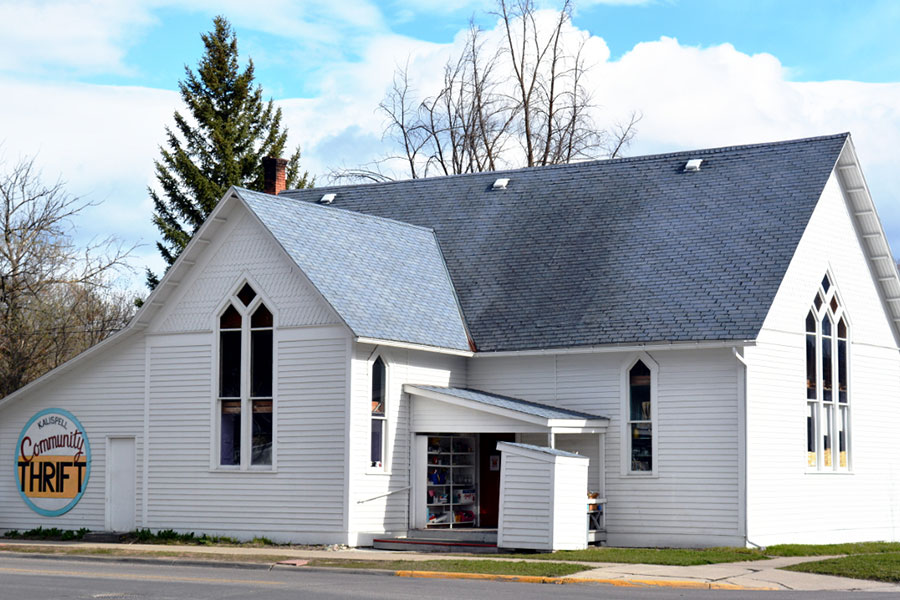The “Scandinavian M. E. Church” at 203 Fifth Ave. W. is a landmark of tremendous significance – well beyond just being “some old church” or long-time thrift store.
The church is indeed a testament to the Scandinavian immigrants who played critical roles in the founding of the Flathead Valley. The congregation was originally known as “Den Norske-Evangolisk Lutherske Menigned av Flathead.” It was chartered on Jan. 27, 1895 by a dozen pioneer (Norwegian) immigrants: H.O. Christiansen, John Foss, Ole Grinde, Lars Johnson, Andrew Pederson, Christian Prestbye, Arndt Nordtome, Mens Nordtome, Robert Nordtome, Andrew Sneen, Eric Sortome, and Rasmus O. Wollan (their names alone are legacies that reach far and wide throughout the valley).
Later that year, The Kalispell Townsite Company donated a lot. And with some $350, the congregation laid the cornerstone for the church in December of 1895, where it has remained ever since. Like many Scandinavian immigrants who came to the Flathead Valley, the founders and other members of the congregation were able farmers and timberjacks, and also accomplished carpenters and tradesmen. And they built the church in their spare time.
In fact, founder Lars Johnson was the contractor for building Central School the year before. Johnson likely did his share of hand-sawing and hammer-swinging in helping to build the church, as did his fellow Norwegian-born immigrant and co-founder Robert Nordtome, who served as the lead carpenter and architect. Incidentally, Nordtome had 10 children, including his son Andy, who relocated the family dairy business just beyond the shadow of the church steeple at 245 Fifth Ave W. in 1922. Indeed, there was plenty of room for cows and a creamery, as the area remained quite rural back then.
Once the building was completed, Norwegians and other Scandinavian immigrants (from Denmark, Sweden, and later Finland) gathered at the church to share their faith and keep their language and customs alive. Indeed, the “Folkekalendar” (social calendar) was quite full, and the church was a revered place where many early immigrants shared much in common — beyond liturgy, lutefisk, and lefse.
While it may be hard to imagine (especially considering the rock-concert-like events of some modern-day fellowships), parishioners came here to worship above whispers in their mother-tongue, the dim of oil lamps, and the crackle of a wood-burning stove (perhaps interrupted now and then by an ornery horse at the hitching post outside).
And for more than 40 years, church services were held in Norwegian, until the church became officially known as the Westside Methodist Church, and services were then held exclusively in English in 1939. Since then, many cultural traditions have faded. And so too have many of the structural elements and symbols of the church as well.
For example, in 1957, the Salvation Army purchased the building and converted it to a thrift shop. Shortly thereafter, the steeple was dismantled (it once stood at the current front entrance). And while the thrift shop business changed hands in 1989, the church is on track to having served customers longer than it has parishioners.
Nonetheless, it remains unmistakably a church. And the narrow, pointed windows and bracketed eaves still nod to the original Late Gothic Revival style of the building (as commonly rendered in the Northwest, that is). And perhaps most importantly, we can fortunately still appreciate the church today, as only a handful of wood-framed churches built before the 1900 remain (most are falling apart or beyond dilapidation).
So the next time you pass by (or go looking for a thrift-shop bargain), be sure to appreciate the “Old Scandinavian Church” as it is both sacred and historic in so many ways.
You can register for Jaix’s “Historic Homes of Kalispell” course and trolley tour at FVCC on May 9 at fvcc.edu or (406) 756-3832.
